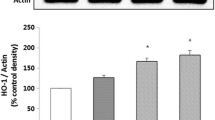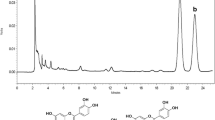Abstract
This study was aimed to evaluate antioxidant activities of a methanol extract from the polar microalgae Fragilariopsis pseudonana (FP) and to investigate the protective effect for gap junctional intercellular communication (GJIC) in WB-F344 normal rat liver epithelial cells. The results indicated that the methanol extract of FP (FPM) scavenged ABTS free radicals and inhibited copper-induced low density lipoprotein oxidation in a dose-dependent manner. Exposing HepG2 cells to FeSO4 increased intracellular reactive oxygen species formation and lipid peroxides, which was significantly reduced by treatment with FPM. Furthermore, FPM increased the activities of superoxide dismutase and glutathione peroxidase in cells. FPM recovered the hydrogen peroxide (H2O2)-induced inhibition of GJIC and attenuated the phosphorylation of connexin 43 (Cx43) and extracellular signal-regulated kinase1/2 (ERK1/2). Taken together, these results demonstrated that FPM has antioxidant activity and protects against H2O2-induced inhibition of GJIC by blocking phosphorylation of Cx43 via activation of ERK1/2.
Similar content being viewed by others
References
Miranda MS, Sato S, Mancini-Filho J. Antioxidant activity of the microalga Chlorella vulgaris cultured on special conditions. Boll. Chim. Farm. 140: 165–168 (2001)
Del Campo JA, Moreno J, Rodríguez H, Vargas MA, Rivas J, Guerrero MG. Carotenoid content of chlorophycean microalgae: Factors determining lutein accumulation in Muriellopsis spp. (Chlorophyta). J. Biotechnol. 76: 51–59 (2000)
Jin DQ, Lim CS, Sung JY, Choi HG, Ha I, Han JS. Ulva conglobata, a marine algae, has neuroprotective and anti-inflammatory effects in murine hippocampal and microglial cells. Neurosci. Lett. 402: 154–158 (2006)
Upasani CD, Balaraman R. Protective effect of spirulina on lead induced deleterious changes in the lipid peroxidation and endogenous antioxidants in rats. Phytother. Res. 17: 330–334 (2003)
Guzman S, Gato A, Calleja JM. Antiinflammatory, analgesic, and free radical scavenging activities of the marine microalgae Chlorella stigmatophora and Phaeodactylum tricornutum. Phytother. Res. 15: 224–230 (2001)
Park JY, Cho HY, Kim JK, Noh KH, Yang JR, Ahn JM, Lee MO, Song YS. Chlorella dichloromethane extract ameliorates NO production and iNOS expression through the down-regulation of NFêB activity mediated by suppressed oxidative stress in RAW 264.7 macrophages. Clin. Chim. Acta 351: 185–196 (2005)
Lee HS, Choi CY, Cho C, Song Y. Attenuating effect of chlorella supplementation on oxidative stress and NFκB activation in peritoneal macrophages and liver of C57BL/6 mice fed on an atherogenic diet. Biosci. Biotech. Bioch. 67: 2083–2090 (2003)
Ha TY, Kang SH, Kwon TY, Ahn JY, Kim SR, Kim DS. Antioxidant activity and contents of bioactive components in polar microalgae. Ocean Polar Res. 28: 37–43 (2006)
Cho JH, Cho SD, Hu H, Kim SH, Lee SK, Lee YS, Kang KS. The roles of ERK1/2 and p38 MAP kinases in the preventive mechanisms of mushroom Phellinus linteus against the inhibition of gap junctional intercellular communication by hydrogen peroxide. Carcinogenesis 23: 1163–1169 (2002)
Arnao MB, Cano A, Acosta M. The hydrophilic and lipophilic contribution to total antioxidant activity. Food Chem. 73: 239–244 (2001)
Lee KW, Hur HJ, Lee HJ, Lee CY. Antiproliferative effects of dietary phenolic substances and hydrogen peroxide. J. Agr. Food Chem. 53: 1990–1995 (2005)
Hwang JW, Park JS, Jo EH, Kim SJ, Yoon BS, Kim SH, Lee YS, Kang KS. Chinese cabbage extracts and sulforaphane can protect H2O2-induced inhibition of gap junctional intercellular communication through the inactivation of ERK1/2 and p38 MAP kinases. J. Agr. Food Chem. 53: 8205–8210 (2005)
Kim JS, Ha TY, Ahn J, Kim HK, Kim S. Pterostilbene from Vitis coignetiae protect H2O2-induced inhibition of gap junction intercellular communication in rat liver cell line. Food Chem. Toxicol. 47: 404–409 (2009)
Kim S, Choi HE, Ahn J, Ha TY. Antioxidative activity of cherry tomato (Lycopersicon lycopersicum var. cerasiforme) extracts and protective effect for H2O2-induced inhibition of gap junction intercellular communication. Food Sci. Biotechnol. 18: 630–635 (2009)
Arnao MB, Cano A, Acosta M. The hydrophilic and lipophilic contribution to total antioxidant activity. Food Chem. 73: 239–244 (2001)
Yagi K. A simple fluorometric assay for lipoperoxide in blood plasma. Biochem. Med. 15: 212–216 (1976)
Ohkawa H, Ohishi N, Yagi K. Assay for lipid peroxides in animal tissues by thiobarbituric acid reaction. Anal. Biochem. 95: 351–358 (1979)
Aebi H. Catalase. Vol. 2, pp. 673–679. In: Methods of Enzymatic Analysis. Vergmeyer MU (ed). Academic Press, New York, NY, USA (1974)
Marklund S, Marklund CT. Involvement of superoxide anion radical in the auto oxidation of pyrogallol and a convenient assay for superoxide dismutase. Eur. J. Biochem. 47: 469–474 (1974)
Lawrence RA, Burk RF. Glutathione peroxidase activity in selenium-deficient rat liver. Biochem. Bioph. Res. Co. 71: 952–958 (1976)
Lowry OH, Rosebrough NJ, Farr AL, Randall RJ. Protein measurement with the folin phenol reagent. J. Biol. Chem. 193: 265–275 (1993)
el-Fouly MH, Trosko JE, Chang CC. Scrape-loading and dye transfer. A rapid and simple technique to study gap junctional intercellular communication. Exp. Cell Res. 168: 422–430 (1987)
Kim EY, Baik IH, Kim JH, Kim SR, Rhyu MR. Screening of the antioxidant activity of some medicinal plants. Korean J. Food Sci. Technol. 36: 333–338 (2004)
Knasmüller S, Parzefall W, Sanyal R, Ecker S, Schwab C, Uhl M, Mersch-Sundermann V, Williamson G, Hietsch G, Langer T, Darroudi F, Natarajan AT. Use of metabolically competent human hepatoma cells for the detection of mutagens and antimutagens. Mutat. Res. 402: 185–202 (1998)
Chen L, Yang X, Jiao H, Zhao B. Tea catechins protect against lead-induced cytotoxicity, lipid peroxidation, and membrane fluidity in HepG2 cells. Toxicol. Sci. 69: 149–156 (2002)
Alía M, Mateos R, Ramos S, Lecumberri E, Bravo L, Goya L. Influence of quercetin and rutin on growth and antioxidant defense system of a human hepatoma cell line (HepG2). Eur. J. Nutr. 45: 19–28 (2006)
Skibola C. The effect of Fucus vesiculosus, an edible brown seaweed, upon menstrual cycle length and hormonal status in three pre-menopausal women: A case report. BMC Complem. Altern. M. 4: 10–17 (2004)
Puiggros F, Llopiz N, Ardevol A, Blade C, Arola L, Salvado MJ. Grape seed procyanidins prevent oxidative injury by modulating the expression of antioxidant enzyme systems. J. Agr. Food Chem. 53: 6080–6086 (2005)
Murakami C, Hirakawa Y, Inui H, Nakano Y, Yoshida H. Effect of tea catechins on cellular lipid peroxidation and cytotoxicity in HepG2 cells. Biosci. Biotech. Bioch. 66: 1559–1562 (2002)
Lima CF, Fernandes-Ferreira M, Pereira-Wilson C. Phenolic compounds protect HepG2 cells from oxidative damage: Relevance of glutathione levels. Life Sci. 79: 2056–2068 (2006)
Lee DE, Shin BJ, Hur HJ, Kim JH, Kim J, Kang NJ, Kim DO, Lee CY, Lee KW, Lee HJ. Quercetin, the active phenolic component in kiwifruit, prevents hydrogen peroxide-induced inhibition of gapjunction intercellular communication. Brit. J. Nutr. 104: 164–170 (2010)
Lee DE, Kang NJ, Lee KM, Lee BK, Kim JH, Lee KW, Lee HJ. Cocoa polyphenols attenuate hydrogen peroxide-induced inhibition of gap-junction intercellular communication by blocking phosphorylation of connexin43 via the MEK/ERK signaling pathway. J. Nutr. Biochem. 21: 680–686 (2010)
Warn-Cramer BJ, Cottrell GT, Burt JM, Lau AF. Regulation of connexin-43 gap junctional intercellular communication by mitogen-activated protein kinase. J. Biol. Chem. 273: 9188–9196 (1998)
Ruch RJ, Trosko JE, Madhukar BV. Inhibition of connexin43 gap junctional intercellular communication by TPA requires ERK activation. J. Cell. Biochem. 83: 163–169 (2001)
Author information
Authors and Affiliations
Corresponding author
Rights and permissions
About this article
Cite this article
Um, M.Y., Kang, S.H., Ahn, J.Y. et al. Antioxidant activity of Fragilariopsis pseudonana and protective effect against hydrogen peroxide-induced inhibition of gap junctional intercellular communication. Food Sci Biotechnol 21, 435–441 (2012). https://doi.org/10.1007/s10068-012-0055-8
Received:
Accepted:
Published:
Issue Date:
DOI: https://doi.org/10.1007/s10068-012-0055-8




